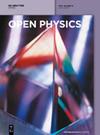Analysis of a generalized proportional fractional stochastic differential equation incorporating Carathéodory's approximation and applications
IF 1.8
4区 物理与天体物理
Q2 PHYSICS, MULTIDISCIPLINARY
引用次数: 0
Abstract
Fractional stochastic differential equations (FSDEs) with fractional derivatives describe the anomalous diffusion processes by incorporating the memory effects and spatial heterogeneities of the porous medium. The stochastic component addresses the random nature of the fluid flow due to the variability in pore sizes and connectivity. The first objective of this research is to prove the well-posedness of a class of generalized proportional FSDEs, and we acquire the global existence and uniqueness of findings under certain settings that are coherent with the classic SDEs. The secondary purpose is to evaluate the continuity of findings in fractional-order formulations. The Carathéodory approximation is taken into account for a class of generalized proportional FSDEs, which is pivotal and provides well-known bounds on the norm of the solutions. Carathéodory’s approximation aids in approximating the FSDEs governing turbulent flows, ensuring the solutions are mathematically robust and physically meaningful. As is widely documented, the existence and uniqueness of solutions to certain types of differential equations can be formed under Lipschitz and linear growth conditions. Furthermore, a class of generalized proportional FSDEs with time delays is considered according to certain new requirements. With the aid of well-known inequalities and Itô isometry technique, the Ulam–Hyers stability of the analyzed framework is addressed utilizing Lipschitz and non-Lipschitz characteristics, respectively. Additionally, we provide two illustrative examples as applications to demonstrate the authenticity of our interpretations. The demonstrated outcomes will generalize some previously published findings. Finally, this deviation from fractional Brownian motion necessitates a model that can capture the subdiffusive or superdiffusive behavior.包含卡拉瑟奥多里近似的广义比例分式随机微分方程分析及应用
带有分数导数的分数随机微分方程(FSDE)通过结合多孔介质的记忆效应和空间异质性来描述异常扩散过程。随机成分解决了由于孔隙大小和连通性的变化而导致的流体流动的随机性问题。本研究的第一个目的是证明一类广义比例 FSDE 的好拟性,我们在某些与经典 SDE 一致的设置下获得了全局存在性和唯一性结论。其次,我们还评估了分数阶公式中结论的连续性。对于一类广义比例 FSDE,考虑到了 Carathéodory 近似,它至关重要,并提供了众所周知的解的规范约束。Carathéodory 近似有助于近似支配湍流的 FSDE,确保求解在数学上稳健,在物理上有意义。正如广泛记载的那样,在 Lipschitz 和线性增长条件下,可以形成某些类型微分方程解的存在性和唯一性。此外,我们还根据某些新要求考虑了一类具有时间延迟的广义比例 FSDE。借助众所周知的不等式和伊托等距技术,分别利用 Lipschitz 和非 Lipschitz 特性解决了所分析框架的 Ulam-Hyers 稳定性问题。此外,我们还提供了两个应用实例,以证明我们解释的真实性。所展示的结果将概括之前发表的一些发现。最后,这种对分数布朗运动的偏离需要一个能够捕捉亚扩散或超扩散行为的模型。
本文章由计算机程序翻译,如有差异,请以英文原文为准。
求助全文
约1分钟内获得全文
求助全文
来源期刊

Open Physics
PHYSICS, MULTIDISCIPLINARY-
CiteScore
3.20
自引率
5.30%
发文量
82
审稿时长
18 weeks
期刊介绍:
Open Physics is a peer-reviewed, open access, electronic journal devoted to the publication of fundamental research results in all fields of physics. The journal provides the readers with free, instant, and permanent access to all content worldwide; and the authors with extensive promotion of published articles, long-time preservation, language-correction services, no space constraints and immediate publication. Our standard policy requires each paper to be reviewed by at least two Referees and the peer-review process is single-blind.
 求助内容:
求助内容: 应助结果提醒方式:
应助结果提醒方式:


